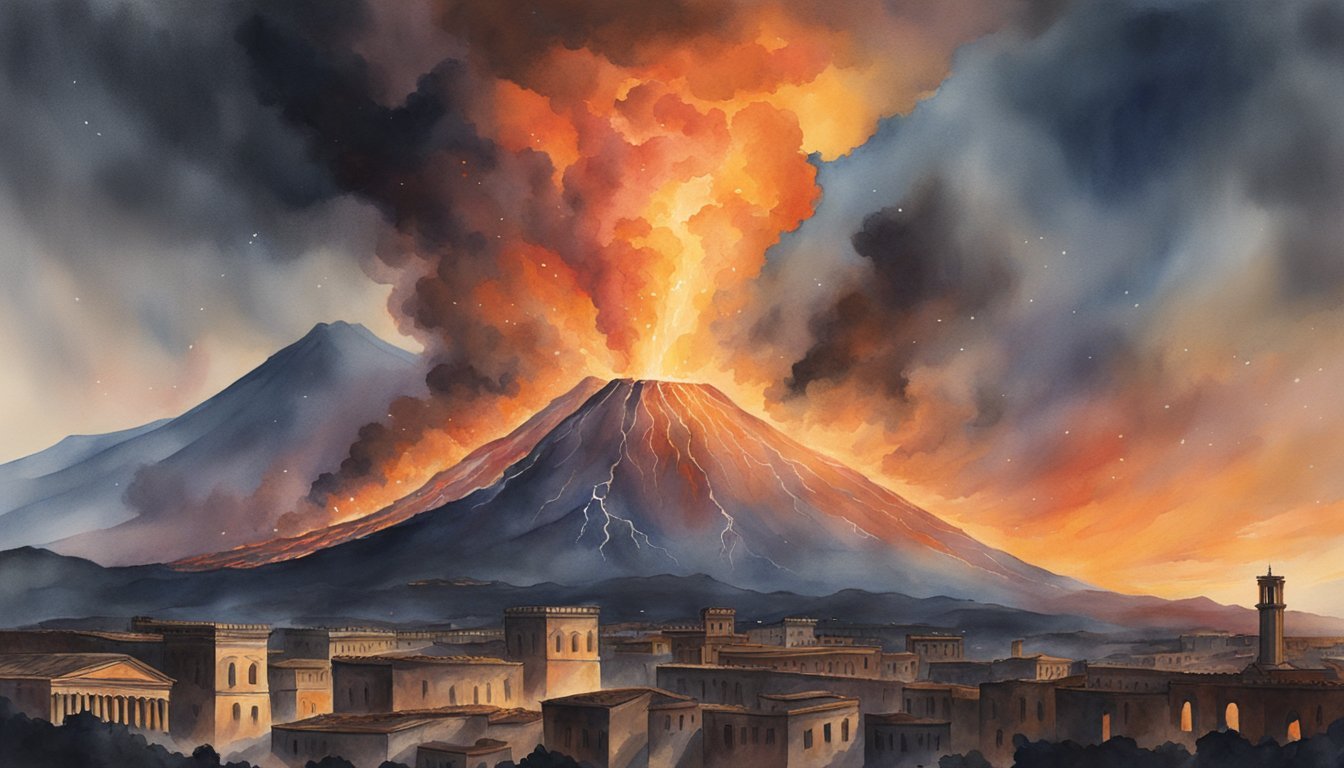The History of Pompeii and Its Eruption
Pompeii has captivated scholars and tourists alike with its rich cultural heritage and dramatic destruction. Its narrative is one of prosperity, catastrophe, and rediscovery, providing a unique window into ancient Roman life.
Pompeii’s Rise and Cultural Mosaic
Pompeii began as a small settlement in the 7th or 6th century BCE, likely established by the Osci or Oscans. It was strategically located in the fertile region of Campania near the Bay of Naples, vital for trade. Throughout its history, the city saw influence from the Greeks, Etruscans, and Samnites before becoming part of the Roman Empire. This amalgamation of cultures is evident in Pompeii’s diverse architecture and artistry that included complex frescoes and intricate sculptures.
Mount Vesuvius’ Eruption on Pompeii: A Timely Account
The catastrophic eruption of Mount Vesuvius on August 24, 79 CE, buried Pompeii and nearby towns like Herculaneum and Stabiae under volcanic ash and debris. Pliny the Younger, a lawyer and author, provided eyewitness accounts of the eruption that proved crucial to understanding the event. The thick layer of ash encompassed the city, preserving it as a testament to the lives of its inhabitants.
Rediscovery and Excavation: Unearthing a Roman Time Capsule
Pompeii lay hidden for almost 1,700 years until its rediscovery in 1599. It was not until the mid-18th century that systematic excavations commenced, revealing Pompeii’s well-preserved ruins. Archaeologists uncovered the Forum, baths, temples, villas, and the city walls that enclosed the ancient city. Pompeii’s exceptionally preserved state offers a snapshot of Roman life, leading to its classification as a UNESCO World Heritage Site. Remarkable discoveries included artifacts such as household items, graffiti, and even preserved skeletons, allowing scientists and historians to piece together the social fabric of this once-thriving Roman city.
The Science and Impact of Volcanic Phenomena

The catastrophic eruption of Mount Vesuvius in 79 CE provides profound insights into volcanic phenomena and their enduring influence on both the natural landscape and human society. The event’s aftermath, including the subsequent preservation of the area, highlights the intersection between nature’s fury and the resilience of civilization.
Volcanological Insights from the Vesuvius Eruption
When Mount Vesuvius erupted, it released copious amounts of volcanic ash and pumice, ejecting these materials high into the atmosphere. The eruption was a display of nature’s power, showcasing a stratovolcano’s capability for explosive eruptions within the Campanian Volcanic Arc. It provided key evidence for understanding pyroclastic surges and flows, phenomena that are characterized by blazingly hot gases, ash, and volcanic debris hurtling down the slopes at high speeds. These surges are considered more dangerous than lava flows due to their speed, heat, and suffocating qualities.
Vesuvius exemplified the horrendous might of what could be described as a major explosion, with parallels often drawn to the destructive energy released by the atomic bomb dropped on Hiroshima. The eruption also offered insights into the sequence of events during an eruption, starting with earthquakes and escalating to the catastrophic climax.
The Aftermath: Effects on the Landscape and Human Lives
In the wake of the eruption, the entire landscape was altered. Settlements like Pompeii were buried under nearly 19 feet of ash and debris, which led to the preservation of buildings, artifacts, and even organic materials such as food, wine, and olives. The devastation resulted in loss of life and obliterated the local economy. Entire communities were wiped out, with the bodies of victims preserved in haunting positions by volcanic ash.
Notably, archaeological excavations at Pompeii and Herculaneum have found that social status, illustrated through villas and their contents, was frozen in time, offering unparalleled historical insights. Items such as amphorae that once held wine or oil, beautifully decorated homes with fountains, and public spaces like the amphitheatre and arena where gladiators once fought tell the story of a vibrant society destroyed in an instant.
Preservation Efforts and Pompeii’s Legacy Today
Preservation of Pompeii and neighboring sites poses a unique challenge. The same volcanic materials that encapsulated the city and safeguarded it for centuries now contribute to its degradation. Over time, exposure to weather and the effects of tourism have taken a toll on the ruins.
Modern preservation efforts are focused on stabilizing and restoring structures, as well as conserving unearthed bodies that provide a poignant glimpse into the lives of those who perished. Pompeii, now one of the world’s most famous archaeological sites, continues to educate us about ancient life in Italy and the destructive power of one of the world’s most dangerous volcanoes.

